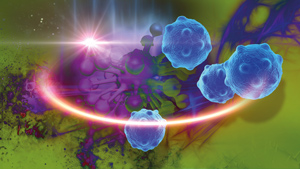Imaging probe yields double insight

A new probe enables multimodal imaging based on photoacoustic imaging and surface-enhanced Raman scattering for studying cancer in living mice. © vitanovski/iStock/Thinkstock
An organic dye that can light up cancer cells for two powerful imaging techniques providing complementary diagnostic information has been developed and successfully tested in mice by A*STAR researchers[1].
Imaging tumors is vitally important for cancer research, but each imaging technique has its own limitations for studying cancer in living organisms. To overcome the limitations of individual techniques, researchers typically employ a combination of various imaging methods — a practice known as multimodal imaging. In this way, they can obtain complementary information and hence a more complete picture of cancer.
Two very effective methods for imaging tumors are photoacoustic imaging and surface-enhanced Raman scattering (SERS). Photoacoustic imaging can image deep tissue with a good resolution, whereas SERS detects miniscule amounts of a target molecule. To simultaneously use both photoacoustic imaging and SERS, a probe must produce signals for both imaging modalities.
In multimodal imaging, researchers typically combine probes for each imaging modality into a single two-molecule probe. However, the teams of Malini Olivo at the A*STAR Singapore Bioimaging Consortium and Bin Liu at the A*STAR Institute of Materials Research and Engineering, along with overseas collaborator Ben Zhong Tang from the Hong Kong University of Science and Technology, adopted a different approach — they developed single-molecule probes that can be used for both photoacoustic imaging and SERS. The probes are based on organic cyanine dyes that absorb near-infrared light, which has the advantage of being able to deeply penetrate tissue, enabling tumors deep within the body to be imaged.
Once the team had verified that the probes worked for both imaging modalities, they optimized the performances of the probes by adding gold nanoparticles to them to amplify the SERS signal and by encapsulating them in the polymer polyethylene glycol to stabilize their structures.
The researchers then deployed these optimized probes in live mice. By functionalizing the probes with an antibody that recognizes a tumor cell-surface protein, they were able to use them to target tumors. The scientists found that, in photoacoustic imaging, the tumor-targeted probes produced signals that were roughly three times stronger than those of unmodified probes. Using SERS, the team was also able to monitor the concentrations of the probes in the tumor, spleen and liver in real time with a high degree of sensitivity.
U. S. Dinish, a senior scientist in Olivo’s group, recalls the team’s “surprise at the sensitivity and potential of the nanoconstruct.” He anticipates that the probe could be used to guide surgical removal of tumors.
The A*STAR-affiliated researchers contributing to this research are from the Singapore Bioimaging Consortium and the Institute of Materials Research and Engineering
Reference
[1] Dinish, U. S., Song, Z., Ho, C. J. H., Balasundaram, G., Attia, A. B. E. et al. Single molecule with dual function on nanogold: Biofunctionalized construct for in vivo photoacoustic imaging and SERS biosensing. Advanced Functional Materials 25, 2316–2325 (2015).
Associated links
A*STAR Research
Media Contact
All latest news from the category: Medical Engineering
The development of medical equipment, products and technical procedures is characterized by high research and development costs in a variety of fields related to the study of human medicine.
innovations-report provides informative and stimulating reports and articles on topics ranging from imaging processes, cell and tissue techniques, optical techniques, implants, orthopedic aids, clinical and medical office equipment, dialysis systems and x-ray/radiation monitoring devices to endoscopy, ultrasound, surgical techniques, and dental materials.
Newest articles

Bringing bio-inspired robots to life
Nebraska researcher Eric Markvicka gets NSF CAREER Award to pursue manufacture of novel materials for soft robotics and stretchable electronics. Engineers are increasingly eager to develop robots that mimic the…

Bella moths use poison to attract mates
Scientists are closer to finding out how. Pyrrolizidine alkaloids are as bitter and toxic as they are hard to pronounce. They’re produced by several different types of plants and are…

AI tool creates ‘synthetic’ images of cells
…for enhanced microscopy analysis. Observing individual cells through microscopes can reveal a range of important cell biological phenomena that frequently play a role in human diseases, but the process of…





















